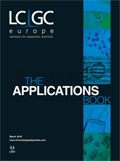Quantitative Analysis of Benzodiazepines in Whole Blood by QuEChERS and LC–MS–MS
Xiaoyan Wang, UCT, LLC
Benzodiazepines are psychoactive drugs widely prescribed for treating anxiety, insomnia, agitation, seizures, muscle spasms, and alcohol withdrawal. Common sample preparation methods to monitor for this drug class in whole blood include a protein precipitation step followed by either a time-consuming
liquid–liquid extraction (LLE) or solid-phase extraction (SPE) procedure. This featured application note describes an easy, fast, and effective method using the QuEChERS approach to provide for their quantitative analysis.

QuEChERS Extraction
- Add 2 mL of acetonitrile with 0.4% formic acid to a 15 mL centrifuge tube containing 400 mg MgSO4 and 100 mg NaOAc.
- Add internal standards (IS), and appropriate amounts of benzo spiking solution to fortified samples.
- Add 1 mL of the negative whole blood into the 15-mL tubes.
- Cap and shake for 1 min at 1000 strokes/min using a Spex 2010 Geno-Grinder.
- Centrifuge at 3000 g for 5 min.
dSPE Cleanup
- Transfer 1 mL of the supernatant to a 2-mL dSPE tube containing 150 mg MgSO4 and 50 mg PSA and 50 mg C18.
- Shake 1 min at 1000 strokes/min using the Spex 2010 GenoâGrinder.
- Centrifuge at 3000 g for 5 min.
- Transfer 0.4 mL of the cleaned extract into a 2-mL auto-sampler vial, add 0.4 mL of reagent water, and vortex for 30 s.
- The samples are now ready for LC–MS–MS analysis.
Instrumental
LC–MS–MS: Agilent 1200 Binary Pump SL / AB Sciex API 4000 Qtrap MS–MS
Column: 100 × 2.1 mm, 3-μm
UCT Selectra® DA LC column,
Guard column: 10 × 2.1 mm, 3-μm
UCT Selectra® DA guard column,
Injection volume: 10 μL
Mobile phase A: 0.1% formic acid in D.I. H2O
Mobile phase B: 0.1% formic acid in methanol
Column flow rate: 0.30 mL/min
Results

Conclusion
Excellent recoveries (85.5–105%) and relative standard deviations (RSD% ≤ 10.7%) were achieved. Matrix effects were found to be minor, ranging from -22% to 18%. This indicates that the QuEChERS technique with dSPE cleanup quickly and effectively removes unwanted matrix interferences that may cause significant ion suppression or enhancement.
UCT, LLC
2731 Bartram Road, Bristol, Pennsylvania 19007, USA
Tel: (800) 385 3153
E-mail: methods@unitedchem.com
Website: www.unitedchem.com

Characterizing Plant Polysaccharides Using Size-Exclusion Chromatography
April 4th 2025With green chemistry becoming more standardized, Leena Pitkänen of Aalto University analyzed how useful size-exclusion chromatography (SEC) and asymmetric flow field-flow fractionation (AF4) could be in characterizing plant polysaccharides.
Investigating the Protective Effects of Frankincense Oil on Wound Healing with GC–MS
April 2nd 2025Frankincense essential oil is known for its anti-inflammatory, antioxidant, and therapeutic properties. A recent study investigated the protective effects of the oil in an excision wound model in rats, focusing on oxidative stress reduction, inflammatory cytokine modulation, and caspase-3 regulation; chemical composition of the oil was analyzed using gas chromatography–mass spectrometry (GC–MS).








